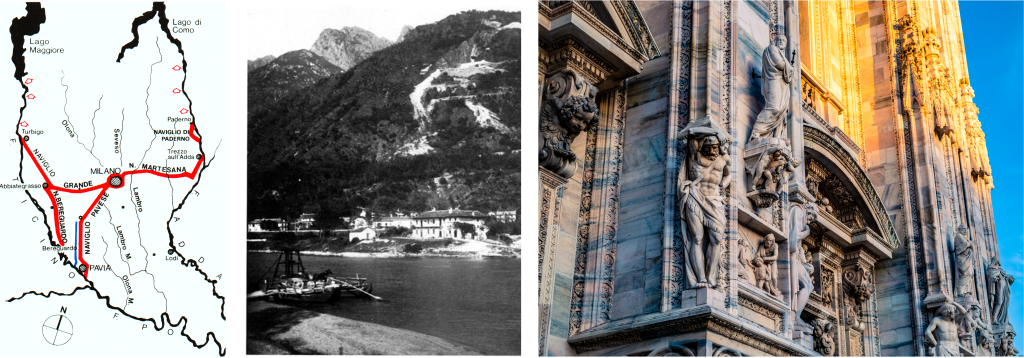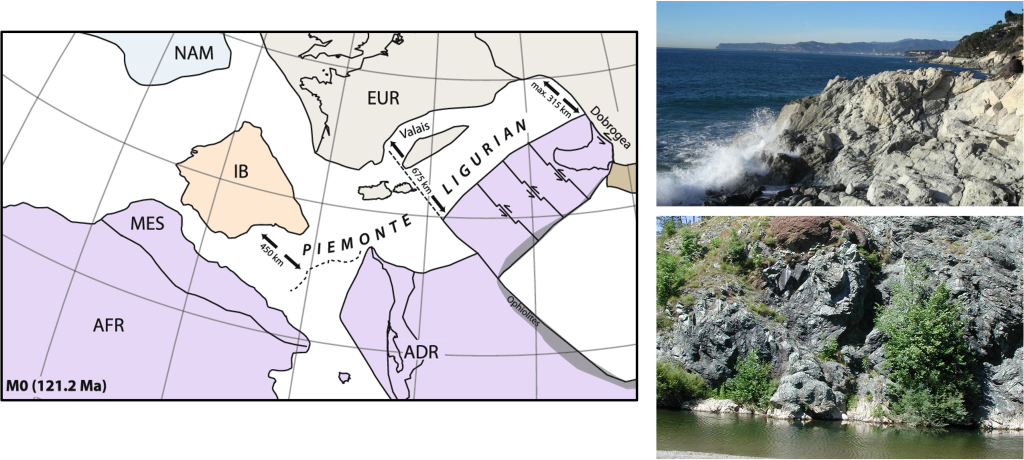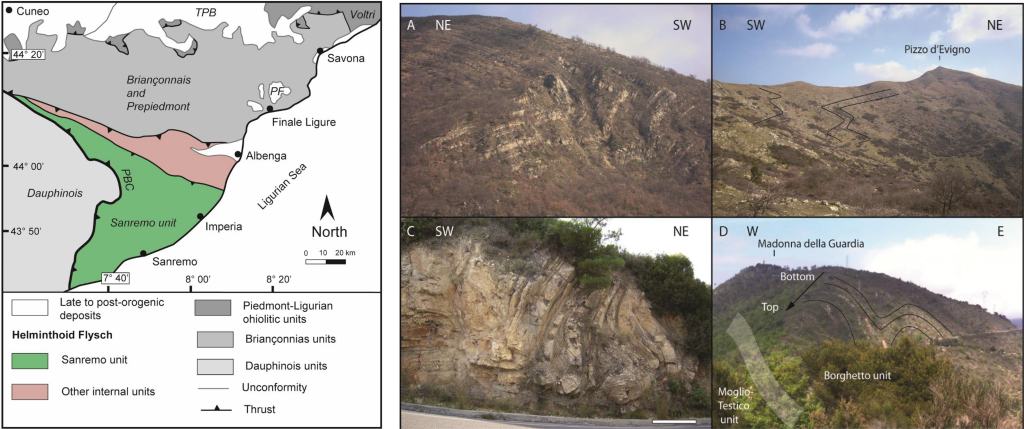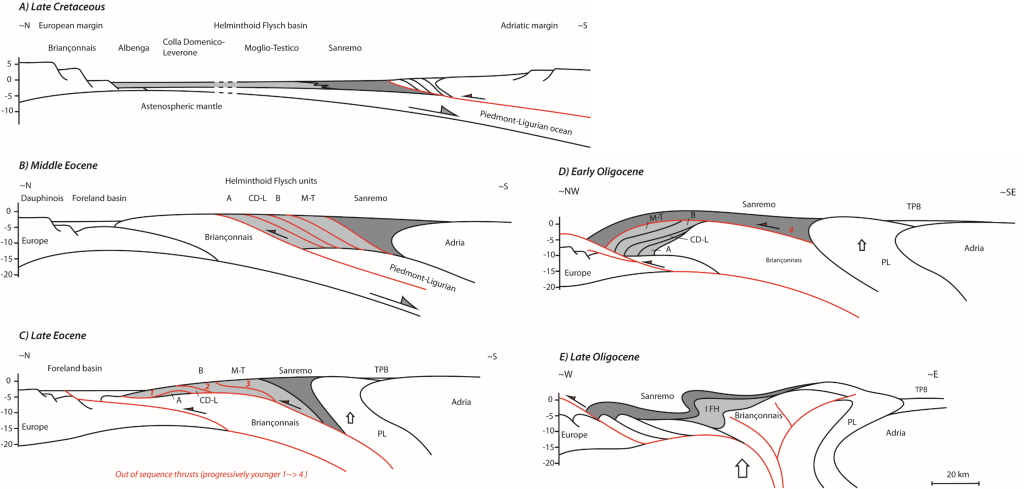Spring has finally arrived, so it’s time for the first big cycling classic of the year: Milano-Sanremo! So time to look at the geology of Milan-Sanremo.
La Classicissima di primavera (the spring classic) is the first of five ‘Monuments’ of cycling. For this year’s 115th edition, the riders will race a whopping 288 kilometers from Pavia (not Milan!) to Sanremo. This makes it the longest one-day race of the year. In this blog, we will take you for a ride along the geology of Milan – Sanremo. We see the many different landscapes of this year’s race, pass mighty rivers, not one but two mountain ranges. And we even cross remnants of a long-lost ocean! After that we treat ourselves to risotto and a glas of wine on the side. Enjoy!
(R)ice, (r)ice baby
For the first time in its long history, Milano-Sanremo starts in the city of Pavia, some 30 kilometers south of Milan. Pavia has one of the oldest universities in the world (founded in 1361). It has a long history going back more than 2000 years! In 89 BC, the Romans established the colony of Ticinum on a strategical position next to the river Ticino. This is on the wide and relatively high plain of the central Po Valley.
This plain formed by glacier-fed rivers that deposited huge amounts of sediments during the Last Glacial Maximum, about 20.000 years ago. When the climate gradually became warmer again in the latest Pleistocene, mighty rivers like the Ticino and Po started digging their way in the plain surface. The erosion created a series of river terraces and steep scarps that can reach heights of more than 10 meters. This gave Pavia a perfect position on the plain. It overlooked the river valleys and protected the city from flooding. Smart move by the Romans!

Risotto
Today, the fertile terraces formed during the last ice age and the abundance of water provide the ideal conditions for the growth of the most famous local product: rice! Pavia is the largest producer of the ‘white gold’ in Europe. There are about 1700 rice farms active in its territory! Who knew that it was the ice ages that created the perfect conditions for growing rice thousands of years later? One thing is clear though: having a big plate of local risotto would surely provide the riders with the energy they need for this year’s race!
Marble marvels
During the first part of the race, the riders cross many of the waterways surrounding Pavia. These include big rivers like the Po but also many artificial waterways constructed in the Po Valley. The main reason for making a network of channels was the transport of goods across the plain. Most importantly: the transport of … rocks! Rocks were in high demand for the construction of many of the medieval and renaissance palaces, churches, and monasteries in rich cities like Pavia and Milano.

Favorite rocks
On the river plains, only sediments like sand and mud were available. That’s why architects started looking in the nearby Alpine mountains instead for the best and most impressive building materials. Their favorite rock: the Candoglia marble. This was already quarried since Roman times near the Lago Maggiore. The builders used the Candoglia marble to build and decorate masterpieces of art and buildings in northern Italy. Marble is a metamorphic rock that mainly consists of carbonate-rich minerals like calcite that have recrystallized under high pressure and temperature. The marble dates from the Paleozoic Era (ca. 250 to 540 million years ago!). It is found within lenses of up to 30 meters in thickness, surrounded by high-grade metamorphic rocks called paragneiss.
The marble consists of recrystallized calcite crystals of >3 mm in size (80-85%) that typically show a pink color. The other 15-20% consists of a bunch of other minerals that are mostly concentrated in colored bands, such as the dark green bands of diopside and tremolite. These bands give the Candoglia marble its characteristic appearance. Today, you can admire the Candoglia marble in many famous buildings in Lombardia, such as the Duomo of Milano and the monumental monastery near Pavia, the Certosa di Pavia.
A small taste of the Apennines
After about 50 kilometers, the riders pass along the foothills of the Apennines. This is the mountain range that runs along the spine of the Italian peninsula. This part of the Apennines is the Oltrepò Pavese. You will not find the most impressive and high mountains here, but rather gentle hills covered mostly by vineyards. Here, they produce high-quality sparkling wines. And the most famous of them all, the Bonarda, has close links to the local geology!

This sparkling red wine is made from a variety of different grapes that grow on soils of different composition. This reflects the large variety in rocks found in the area. These grapes grow on many different rock types (see map), including layers of clastic sediments, limestones, and magmatic rocks. Combining these grapes gives the wine its typical complex taste. Besides providing rich flavors to grapes, the rocks of the Oltrepò Pavese also played a role in establishing the geological timescale. The Tortonian stage, from 11.6 to 7.2 million years ago, was named after the city of Tortona, which the riders pass after exactly 70 km.
Luckily for the riders, they do not see much of these rocks from up close, since they pass all the hills and mountains to head straight to the Ligurian coast. Despite this, they will deserve a good glass of local wine of racing for nearly 300 kilometers!
A hidden ocean
Just after crossing the Apennines via the Passo del Turchino, the riders reach the coast of Liguria in the town of Voltri. This town is well known by geologists, as it gives its name to the Voltri Massif. This massif preserves an amazing record of a long-lost ocean: the Piemonte-Ligurian ocean. This ocean formed during the late Jurassic (about 170 to 145 million years ago) by slow oceanic spreading between the continents of Europe, Iberia and Adria. This ocean did not last very long though! When plate tectonic forces changed in the Cretaceous, the continents of Adria, and its larger brother Africa – to which it was basically attached – started moving toward the European continent. During this time, the relatively dense oceanic plate started sinking below the continental plate of Adria. This is a process called subduction.
From the deep

The rocks that made up the oceanic crust, as well as the sediments deposited on the ocean floor, reached great depths. Under high pressure they changed to different rock types. This created beautiful rocks such as serpentinite and eclogite. The collision continued, squeezing some of the metamorphosized oceanic rocks back from great depths all the way to the surface. This mind-boggling process makes it possible to see these rare rocks that were once hidden in the deep back at the surface in Liguria today!
No time to waste
Such rare occurrences of former oceanic plate that are not preserved on land are called ophiolites. In fact, the Ligurian ophiolites are one of the most famous and well-studied ophiolites in the world! To preserve this exceptional geological heritage, the regional authorities created the Beigua Geopark. This park is a UNESCO global geopark since 2015. It offers a whole range of activities to let people experience and learn more about the local geology. Unfortunately, the riders have little time to look at some well-preserved rock outcrops along the coastal road. The race is heading towards its finale!
An Alpine finish
Racing along the coast of Liguria, the peloton gets increasingly nervous for the hilly final 50 kilometers. Although Milano-Sanremo is known as the most important classic for sprinters, in recent years puncheurs like Mathieu van der Poel won here too. Geologically speaking however, this is a true mountain race!

After crossing the Apennines and traversing a lost ocean, the last part of the race takes place in another mountain range – the (Ligurian) Alps! The Ligurian Alps are part of the ancient collision zone of Europe and Adria. This collision followed the closure of the Piemonte-Ligurian ocean, as discussed above. The geology of the area around Sanremo provides clear evidence of this!
The Sanremo unit
Here, the aptly named Sanremo Unit is found. It mostly consists of mudstones and sandstones that were deposited in the sea between Europe and Adria. Many rocks found here are so-called turbidites. They form by underwater avalanches named turbidity currents. These flows of sand and mud run down the shallow slope of the sea floor and are responsible for depositing vast amounts of sediment. A sequence of clastic sedimentary rocks that forms during an episode of mountain building is called ‘flysch’.

Over time, the Helminthoid Flysch, to which the Sanremo Unit rocks belong, ended up right in the middle of the continental collision that formed the Ligurian Alps (see figure)! They were heavily deformed and folded when they were squeezed between the larger landmasses of Europe and Adria. Now, these folded turbiditic rocks of the Ligurian Alps form the famous hills of Milano-Sanremo such as the Poggio di Sanremo. And after racing for 285 km, the Poggio will truly feel like climbing an alpine col!







